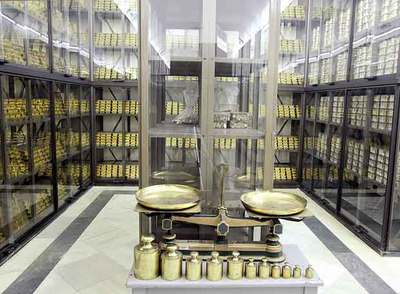Mercantilism was the first economic theory in history and the predominant economic policy developed by the first State-nations between the 16th and 18th centuries. It was based on the idea that the power of a country was related to the quantity of precious metals it could accumulate. The wealthier a country was, the more powerful it would be. And the best way of getting more precious metals was reducing imports, promoting exports and developing international trade. That´s why the main European powers built colonial empires, supported trading companies during the 16th-18th centuries and imposed tariffs to the foreign products that arrived in their ports. This policy could be considered a precedent of protectionism.

Jean- Baptiste Colbert promoted mercantilism in France
If you want to learn more about mercantilism, you can visit the following links:
The States started accumulation gold and silver reserves during the Modern Era. In the 17th Sir Isaac Newton, the famous scientist, was the first to establish the gold standard (the correspondence between the gold reserves a country had and the amount of coins that could be minted and circulate). But the gold standard wasn´t officially adopted in Great Britain until 1774. In other countries gold and silver standards coexisted until the 19th century. The British were also the first to create a central bank, in charge of minting the official currency of the country. In 1844 the Bank Charter Act established that every currency minting had to be supported by gold reserves. That was the origin of the gold reserves every country stores in their central banks. In war times different countries left the gold standard temporarily, in order to print more banknotes to be able to buy the resources they needed. In the Spanish case, the government of the Second Republic had to transfer 510 tonnes of gold (72.6% of its gold reserves) to the USSR to finance supplies and weapons to defend legality against those who had rebelled against the government. This was the so called Moscow Gold
As the USA became the main world economic power after World War 2, many countries started accumulating dollar reserves (foreign exchange) together with gold. But this created a problem to the USA, because they didn ´t have enough gold to cover all the dollars stored in many countries. In 1971 USA president Richard Nixon decided unilaterally to suspend the direct convertibility of the dollar to gold and this meant the end of gold standard as the way of organizing the international monetary relations. However, the States continue to accumulate gold reserves. Here you have a graph where you can see the top 20 countries in gold reserves:

And here you have a more complete list:
The price of gold has increased a lot in the last years, because it is considered to be a refuge value, a safe investment. If Spain sold its gold reserves (281.6 tonnes), the price would be around 11,335 million €

Bank of Spain gold vault
Gold is supposed to be a safe value, but we shouldn´t forget that it´s only a scarce metal humans have decided to consider very valuable.
If you want to learn more about gold reserves, here you have another interesting link:
No comments:
Post a Comment